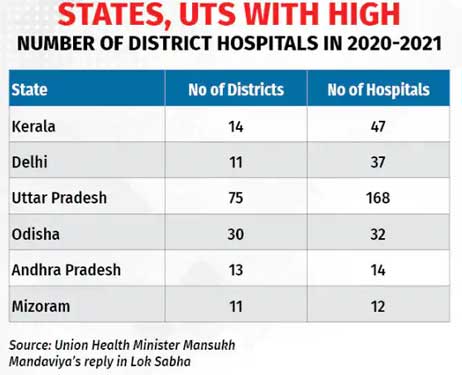40% of Districts Do Not Have Nursing Colleges
Context
According to data received by The Hindu from the Health Ministry, there are no nursing colleges in 40% of the districts in India. In reality, three western States only have 17% of the nursing institutions, compared to five southern states with 42%.
What did the data accessed by the hindu on Nursing colleges reveal?
- According to data received by The Hindu, there are no nursing institutions in 40% of the districts in India, which results in uneven access to nursing education and training across the nation.
Where is the geographical concentration of most of these colleges?
- The data also shows that the distribution of nursing institutes is unbalanced. Only five southern states—Andhra Pradesh, Karnataka, Kerala, Tamil Nadu, and Telangana—are home to 42% of nursing colleges.
- Alternatively, three western states—Rajasthan, Gujarat, and Maharashtra—comprise 17% of nursing institutions, demonstrating a regional specialization of nursing education.
- Although there have been 36% more colleges offering undergraduate nursing education since 2014–15, the rise has not been consistent between states.
- There is a concentration of nursing professionals in particular areas, as evidenced by the fact that only eight states currently train about 64% of the nursing workforce.
- This disparity results in a shortage of trained nurses in the northeastern states and further contributes to the regional imbalance in healthcare services.
What is the present Nurse-to Patient Ratio that is present in our country?
- India has about 35 lakh nurses, yet its nurse-to-population ratio is only 2.06 nurses for every 1000 people. This ratio is below the benchmark of three nurses per 1,000 people set globally.
- The low nurse-to-population ratio has an impact on the standard of healthcare services and makes it more difficult to successfully meet population healthcare needs.
What are the consequences of having a low Nurse to Patient ratio?
- Decreased Quality of Care: With fewer nurses available to attend to patients, the quality of care may suffer. Nurses may have less time to spend with each patient, leading to rushed assessments, lower attention to detail, and reduced personalized care.
- Increased Patient Mortality and Complications: Studies have shown that higher nurse-to-patient ratios are associated with better patient outcomes, including lower mortality rates and fewer complications. When the ratio is low, nurses may be spread thin and unable to provide the level of monitoring and intervention required for critical patients.
- High levels of stress and burnout: This can occur in overworked nurses, which can lead to job dissatisfaction and nursing burnout. Low nurse-to-patient ratios can result in longer shifts and more work, which is bad for nurses’ health and job happiness.
- Longer Wait Times and Delays: Due to the shortage of nurses, patients may have to wait longer to obtain treatment or medication. Delay in treatment and deterioration of health issues are potential outcomes.
- Reduced Patient Education and Preventive Care: Nurses are crucial in patient education and preventive care. There might be less time and money available with fewer nurses to teach patients how to manage their medical conditions and avoid further health issues.
What is the global situation on this situation?
- The World Health Organization (WHO) reports a global shortage of health workers, with nurses and midwives accounting for more than 50% of the shortfall.
- Southeast Asia and Africa experience the most significant shortages of nurses and midwives, highlighting the global challenge in addressing healthcare workforce gaps.
What measures can Government take in improving the situation?
- The government has implemented a plan to co-locate 157 new nursing institutions with medical colleges by April 2025 to solve the geographical discrepancy. In areas without nursing colleges, this co-location model should improve nursing education.
- Additionally, short-term training courses have been developed to give nurses the chance to expand their skills. However, due to subpar execution in some jurisdictions, the impact of these policies has been limited.
To address these issues, the federal and state governments must work closely together. They must also make better use of the programs and funding available for nursing education, upgrade the healthcare system in underserved areas, and create plans to promote nursing education and training where there is a shortage. Improving the overall healthcare system and addressing the healthcare needs of India’s expanding population depend on funding nursing services and bolstering the nursing workforce.





